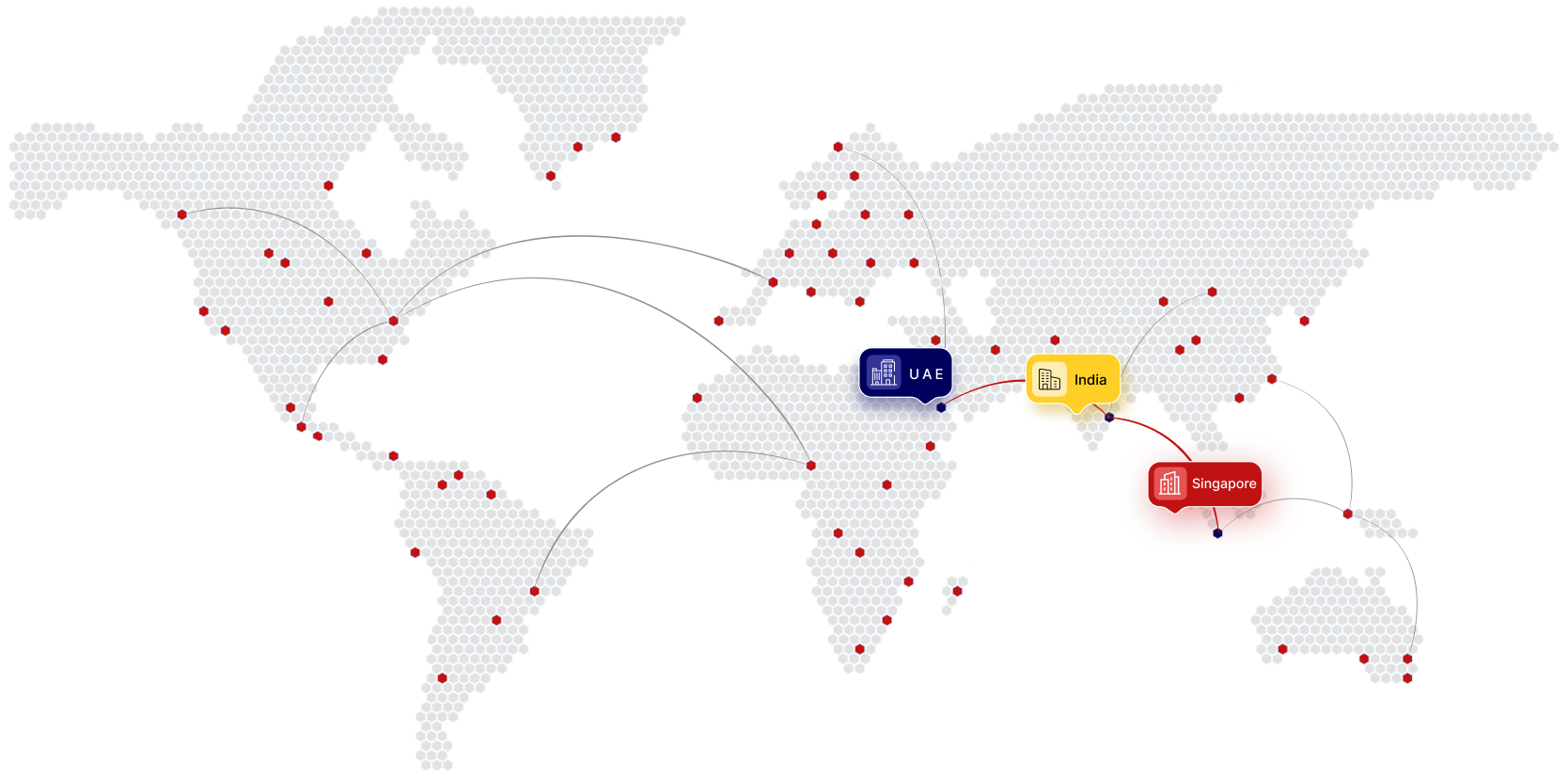- Article
- February 18, 2015
The Dubai International Financial Centre (DIFC) has recorded a growth of 7% in the number of actively registered companies as well as its workforce during the first half of the year, much of it driven by new businesses from Asia, Middle East, Europe and North America wanting an exposure to the relatively stable business environment and sustained recovery of the emirate.
During the same period, occupancy of the DIFC-owned leasable space is up to 97% from 94 %.The retail space has grown to 99 %, with the total leasable commercial space increasing by 122,000 square feet, which is a six per cent increase over the end of last year.
The number of active registered companies which is physically doing businesses within the DIFC, grew to 979 with 1,000 new jobs added bringing the total number of employees to 15,000.
At a media roundtable in Dubai, the chief executive of DIFC Authority Mr. Jeff Singer said, “We are becoming the established international financial centre for the Middle East, Africa and South Asia region”.
For more details reach us at [email protected]
- Article
- February 18, 2015
Abu Dhabi and Dubai topped the list of the Middle East and North African cities in terms of disposable income per capita in 2013 with $13,496 and $12,543 respectively. This was revealed by Economic Intelligence Unit (EIU), which covered 26 cities from 16 countries in the Middle East and North Africa (MENA) region.
The EIU considered, based on the disposable income criterion. Abu Dhabi and Dubai the richest cities in the region. They were followed by Riyadh in the third place with $11,700, Kuwait in the 4th place with $11,429 and Doha in the 5th place with $11,045. Istanbul came in the 9th place with $10,061, while Marrakech came last in the 26th place with $2,063, preceded by Algeria in the 25th place with $2,217.
In a report titled “Mena Cities Prepare for Opportunity” issued in January, the EIU said Dubai’s expenditure totaled around $29.7 billion in 2013, placing Dubai in the 5th place in the region, while Abu Dhabi’s expenditure totaled around $17.8 billion. During the same period, Dubai’s population totaled 2,367,493 compared with 1,317,388 in Abu Dhabi.
In contrast, Abu Dhabi came in the 9th place and Dubai in the 10th place in terms of the annual spending per capita with $8,956 and $8,841 respectively. Riyadh topped the list with $11,175, while Algeria and Basra came at the bottom of the list with $2,083 and $1,766 respectively.
For more details reach us at [email protected]
- Article
- February 18, 2015
In order to further strengthen the relations in financial services between Dubai, Hong Kong and Asia, the Chairman of the Dubai Financial Services Authority (DFSA), Mr Saeb Eigner, delivered an address in the seventh Asian Financial Forum, Hong Kong.
The forum was attended by 2,400 delegates from Asia, Europe and America, where finance ministers, central bankers, heads of governments and business leaders gathered to discuss economic developments and business trends in China and the rest of Asia. “The future will belong to vibrant cities like Hong Kong and Dubai which continue to pioneer, innovate and implement strategies quickly and efficiently with visionary leadership and efficient governments,” Mr Eigner said.
Dubai enjoys excellent trade and finance relationships with Hong Kong and the rest of Asia. These will continue to grow in 2014, including in the Islamic finance arena. Since His Highness the Ruler of Dubai announced the initiative for Dubai to be the global hub for the Islamic economy, plans are moving ahead, with the necessary legislation already in place. In 2013, the DFSA witnessed many successful issues of sukuk on NASDAQ Dubai, where USD6bn worth of sukuk were listed, up from USD1bn in 2012.
Due to the highly international nature of Dubai and the DIFC, the DFSA has placed great emphasis in its work on international co-operation and collaboration. This has included building regulatory relationships with the Hong Kong Securities and Futures Commission, the China Banking Regulatory Commission, the China Securities Regulatory Commission and with the Reserve Bank of India.
For more details reach us at [email protected]
- Article
- February 17, 2015
MUMBAI | NEW DELHI: India Inc’s quest for growth in what is now the world’s fastest-growing major economy is starting to show some results. Its entrepreneurs are becoming richer as cash-hungry private equity firms chase ambitious start-ups and ecommerce firms; consumers are happier as discount deals become a daily, predictable affair rather than an annual or semi-annual event; and the much sought-after, talked-about right sizing of corporate balance sheets is becoming a reality as hard-nosed len ders crack down on bad loans and promoters become more pragmatic in selling assets.Ending months of soul searching, Suzlon promoter Tulsi Tanti decided to lighten up Suzlon’s stretched balance sheet by selling his German crown jewel Senvion for over a billion bucks a few weeks ago. A fortnight later, Anand Mahindra looks all set to bulk up his defence sector presence through a strategic acquisition of Pipavav Defence BSE 6.66 %
Most of the m&a activities spurred by lender pressure
In between, Alibaba’s Jack Ma smelled an opportunity in the booming mobile commerce space and committed a $575-million cheque to debut in India with an investment in Paytm while India’s largest private sector insurer ICICI Prudential Life got busy prepping up in anticipation of a liberalised foreign investment regime to raise additional funds and create a valuation marker of $6 billion prior to its IPO in the near future. These are some examples of how India Inc is trying to prepare for a future laden with opportunities and challenges. Rightsize, downsize, sell loss-making assets, buy growth wherever possible and raise money in a market which was the world’s second-best performer in dollar terms in 2014. It’s just 2 months into the new year and deal street has already shrugged off its ennui. The buzz is most certainly back.
This month alone, nearly five deals either got announced or were close to being concluded in the past week. Star TV announced that it is buying Telugu entertainment channel MAA for over Rs 2,000 crore, while Economic Times broke the story that several pharma firms are in the race to buy Claris Life Sciences’ injectable business for Rs 2,500-3,000 crore. Singapore’s Sembcorp announced that it will buy 60% in IDFC-backed Green Infra for over 1,000 crore while Dilip Shanghvi of Sun Pharma BSE -2.52 % announced a personal investment of 1,800 crore into Tulsi Tanti-promoted Suzlon. Rainmakers insist that it’s not just episodic M&A but in general, activity levels are picking up even in debt and equity capital markets. This after a roaring 2014 when the value of announced M&A deals involving Indian companies rose to $37 billion, a 25.5% increase compared with 2013. This value was the highest since 2011, according to data culled by Thomson Reuters. The average deal values too climbed as more number of bigger deals ($500-million-and-above) were announced. Experts and rainmakers believe this is just the beginning and deal activity will pick once the economy starts growing and companies regain confidence in demand projections. The perception of India among global investors has undergone a dramatic change over the past 12 months with a strong RBI governor delivering lower inflation and a stable exchange rate, feels Frank Hancock, Managing Director, Corporate Finance, at Barclays.
“Meanwhile, the stable new administration at the Centre has reasserted policy stability, thereby reversing the flight of capital. The debt market in particular is now very active, and Indian companies are taking advantage of both equity and debt-raising opportunities to refinance high-cost debt and create acquisition war chests,” he adds. Obviously, much of the activity has been spurred by lender pressure. Record high NPAs and pressure on profits means banks are no longer willing to tolerate business-as-usual stance of promoters with high debt and no meaningful downsizing strategy. They are pushing promoters to sell projects and companies even if it means a loss. Suzlon recently sold its German wind business for one billion euros after buying it for about 1.4 billion euros in 2009.
“This is the consolidation phase in power, cement, steel or infrastructure. This is the first sign of optimism as some amount of confidence and trust is coming back in India Inc. The second phase will see rollout of new plants and capex. But that is still 1-2 years away once policies fully unfold. In a way, these takeovers are also a kind of capex for the acquirers,” says Sushil Maroo, CEO, Essar Energy. These takeover talks have multiple catalysts. As regulators, lenders as well as investors tighten their screws, stressed companies are pro-actively looking to pare assets to cut debt. From Jaypee to Kesoram and Bharti; or from Lanco to Crompton Greaves – cutting across sectors and scale of business, India Inc has prioritised portfolio rebalancing through hive-offs, asset or business sales.
“Well-meaning promoters, who are at a group level strapped for liquidity due to various reasons, particularly policy inaction — are seriously considering divesting assets. These promoters have a serious intent to reduce their leverage position,” says Sanjay Nayar, CEO and Country Head of KKR India. This in turn has triggered large-scale domestic consolidation in sectors as diverse as power and multiplex. Secondly, larger Indian groups like Mahindra and JSW are taking steps to increase their domestic exposure after the government’s positive measures. For the insurance players like ICICI Pru Life or HDFC Standard Life, the new regulatory regime also gives hope to rework the equity structure of their JVs and capitalise their business. Inbound deals too are gaining momentum as many cash-rich multinational companies are looking to increase their India presence or even enter India and finally ambitious domestic players are gaining confidence to shop for assets overseas.
“With improved business sentiment, typically you will first see activity in the capital markets followed by domestic M&A and inbound deals, and then outbound acquisitions,” says Kaku Nakhate, president and country head, Bank of America Merrill Lynch. The capital market revival is already a one-and-a-half-year-old story but very few companies have attempted to cash in on it through share sales, IPOs and other forms of fund-raising. In 2015 so far, that is already changing. In the beginning of this month, HDFC Bank BSE 0.75 % raised about Rs 10,000 crore by selling American Depository Receipts and India-listed shares to qualified institutional investors in the largest follow-on offer by a private sector firm. Even Reliance Industries hit the forex debt market second time in as many weeks to raise about $1 billion in a benchmark 30-year paper — a first from Asia since 2003. This was within 10 days of another billion-dollar refinancing via 10-year bonds.
If the story is good, global investors are once again willing to bite. Even selling the India infrastructure theme has become easier – GMR Infrastructure flagship Delhi International Airport raised $289 million through a considerably oversubscribed bond issue just last month which saw $5-billion interest from investors. After a lull, blue-blooded private equity and sovereign wealth funds like Temasek are also back in the mix. By the end of this month, several large trades – CMS, Destimoney — are also due to get announced. With a soaring Sensex, the prospects for many of these funds to exit their portfolio companies have also improved. So over the next 3-6 months, from entertainment parks to diagnostic chains; from wellness players to toll road operators and agri-warehouses, IPOs are set to flood the capital markets. “There is cautious optimism all around and the Budget is expected to provide direction for accelerated growth and investment. While waiting for private and foreign strategic capital to be invested in new projects, the government can spur growth by spending on infrastructure and encouraging public sector companies to undertake capital expenditure. Investment by private sector and multinationals will follow when they witness sustained economic recovery and growth opportunities” argues Ravi Kapoor, Head of Corporate & Investment Banking at Citigroup India.
The biggest beneficiaries have been ecommerce firms and start-ups in other sectors. Online retail firms have been aggressive fund-raisers in the past two years as they wanted to invest to capture growth. The industry in India has grown at a swift pace in the last 5 years from around Rs 15-billion revenues in 2007-08 to Rs 139 billion in 2012-13, translating into a compounded annual growth rate (CAGR) of over 56%, rating agency Crisil BSE 1.17 % said in a report on February 2014. The nine-fold growth came on the back of increasing internet penetration and changing lifestyles, and was primarily driven by books, electronics and apparel. Crisil Research expects the buoyant trend to sustain in the medium term, and estimates the market will grow at a healthy 50-55% CAGR to 504 billion by 2015-16. India’s largest online retailer Flipkart’s value rose to $7 billion (including the $1-billion fund raise) in August when it received $1 billion in fresh capital while it was valued at less than $3 billion in May. It has received $1.8 billion since it started out in 2007, including $1.57 billion over the past 15 months.Its rival Snapdeal’s valuation rose to a billion dollars after it raised $100 million from Blackrock, Temasek and other investors. Tata Group’s former chairman Ratan Tata is an investor in the etailer. Most expect M&A activity to pick up further in the second half of the year. But for that to fructify, a confidence trigger like an investor-friendly budget is a must. “As share prices rise, the Indian M&A market will start to see another reversal of sentiment. From being the buyer’s market over the past few years, I expect to see the gradual re-emergence of India’s outbound M&A paradigm as companies will seek new technologies and markets, in healthcare, technology, and industrials,” adds Hancock.
For more details reach us at [email protected]
- Article
- February 17, 2015
Gold volumes increase 23% year-on-year
The Dubai Gold & Commodities Exchange (DGCX) recorded a robust start to the year with a total of 1,176,111 contracts traded in January, an increase of 22 per cent over December 2014, said a press statement on Wednesday.
The metals segment was the main driver of volume growth, growing 24% month-on-month with 55,661 contracts traded.
DGCX’s flagship product, Gold Futures led the growth, trading 47,206 contracts in January, up by 13% month-on-month and 23 per cent year-on-year.
DGCX’s currency segment grew 13 per cent year-on-year. The Mini Indian Rupee Futures grew 39 per cent year-on-year and 24 per cent from the previous month while Indian Rupee Futures grew 23 per cent month-on-month, the statement said.
The Hydrocarbon segment witnessed a 22 per cent growth from the previous year. WTI Futures led the growth, rising 21 per cent month-on-month and 13 per cent year-on-year.
Other new products also performed well with the MSCI Indian Rupee and US Dollars Indices growing 133 per cent and 189 per cent, respectively, and the Mini INR denominated in British Pounds and Euro, both introduced in November, rose 55 and 25 per cent, respectively.
Gaurang Desai, Interim CEO of DGCX, said: “Through 2015, we remain committed to exploring new opportunities with our Members and the market in order to diversify our product portfolio.”
For more details reach us at [email protected]
- Article
- February 17, 2015
Puerto Rico’s Governor, Alejandro García Padilla, on February 11, 2015, presented legislation to overhaul the nation’s tax regime, including the introduction of a value-added tax (VAT) and substantial cuts to income tax rates.
Confirming the reforms, García Padilla said: “We currently have a tax system that penalizes work and productivity while encouraging evasion. It is inefficient and unfair. The current system punishes the middle class and the poor that work so hard to provide for their families.”
He said that the tax overhaul aims to “evenly distribute the tax responsibility amongst citizens.” Currently income tax is the principal source of revenue for the territory, with 85 percent being paid by salaried workers and the remaining 15 percent coming from self-employed persons. However, García Padilla noted that only 12,000 people file tax returns including income of USD150,000 or more, which he said is in stark contrast to the luxury cars and houses seen on the territory’s streets.
“The current system hinders economic development because it rests on the shoulders of our hard workers,” he continued. “Over 80 percent of those that pay taxes are working class people who are unable to hide their income or come up with exemptions and avoid paying. The fact that some pay while others ignore their tax responsibility is an injustice that needs to end now.”
Under the plans, the Sales and Use Tax (SUT) and the Gross Receipts Tax (Patente Nacional) will be replaced with a VAT. With the expansion of the consumption tax base, Puerto Rico will introduce a personal income tax-exempt threshold of USD40,000 for individuals and USD80,000 for married couples, removing 850,000 taxpayers from the tax net.
According to García Padilla, effective personal income tax rates will be no higher than 21 percent under the new system, down from as high as 38 percent currently, and the tax rate on corporations will fall to 25 percent.
In addition, it is proposed that those on incomes below USD35,000 would get a refund of VAT, and those on incomes below USD20,000 would receive a full refund. Prescription medication, groceries, private property leasing, and public schools would be exempt from all taxes, he added.
“With this tax system overhaul we can help direct the island’s revenues towards the future, and ensure that we will borrow less, pay our current debts, and pay down the debt previous administrations committed to without the appropriate means for repayment,” he concluded.
For more details reach us at [email protected]
- Article
- February 17, 2015
On February 6, 2015, the Organisation for Economic Co-operation and Development (OECD) announced that it has reached agreement with the Group of Twenty (G-20) Finance Ministers on three key elements of its base erosion and profit shifting project.
The three elements, which the OECD said will enable implementation of the BEPS project and will be presented at the G-20 Finance Ministers’ meeting on February 9-10, 2015, in Istanbul, Turkey, include:
- A mandate to launch negotiations on a multilateral instrument to streamline implementation of tax treaty-related BEPS measures;
- An implementation package for country-by-country (CbC) reporting in 2016 and a related government-to-government exchange mechanism to start in 2017; and
- Criteria to assess whether preferential treatment regimes for intellectual property (patent boxes) are harmful or not.
Announcing the development, OECD Secretary-General Angel Gurría said: “These are important steps forward, which demonstrate that progress is being made toward a fairer international tax system. These decisions signal the unwavering commitment of the international community to put an end to [BEPS], in line with the ambitious timeline endorsed by G-20 leaders.”
The planned multilateral instrument will offer countries a single tool for updating their networks of tax treaties in a rapid and consistent manner. The agreed mandate authorizes the formation of an ad hoc negotiating group, open to participation from all states. The group will be hosted by the OECD, and will hold its first meeting by July 2015, with an aim of concluding the drafting process by December 31, 2016.
Countries agreed new guidance on CbC reporting by multinationals with a turnover above EUR750m (USD584m) in their countries of residence starting in 2016, with tax administrations to start exchanging the first CbC reports in 2017. The guidance confirms that the primary method for sharing such reports between tax administrations is through automatic information exchange, pursuant to government-to-government mechanisms such as bilateral tax treaties, the Multilateral Convention on Mutual Administrative Assistance in Tax Matters, or Tax Information Exchange Agreements. In certain exceptional cases, secondary methods, including local filing, can be used. Countries have also emphasized the need to protect tax information confidentiality.
Countries endorsed a solution to determine which intellectual property regimes (patent boxes) and other preferential regimes can be considered harmful tax practices. The solution, first proposed by the UK and Germany, is based around a “modified nexus approach,” which seeks to ensure that tax breaks are limited to those activities with substance in the territory providing the concessionary treatment. Transitional provisions for existing regimes, including a limit on accepting new entrants after June 2016, have been agreed, and work on implementation is ongoing, the OECD said.
Officials from more than a dozen developing countries participated in the discussion on the new BEPS implementation guidance, in line with the broader strategy for deepening engagement of developing countries in the BEPS project, which was launched on November 12, 2014, and welcomed by the G-20 Leaders in Brisbane, Australia.
For more details reach us at [email protected]
- Article
- February 17, 2015
A delegation from the Mexican Government met with officials from the regulatory body of Brazil’s Manaus Free Trade Zone on February 4, 2015, to study the structure of the free zone.
The visit followed an announcement by the Mexican Government that it plans to establish three special economic zones (SEZs) in the southern states of Guerrero, Chiapas, and Oaxaca to boost development in the region.
The delegation was led by Mexico’s Ambassador to Brazil, Beatriz Paredes, and included a number of officials from the Mexican Ministry of Finance.
In August last year, the Brazilian Government enacted legislation extending the validity of the Manaus Free Trade Zone until 2073. The tax incentives of the zone had been due to expire in 2023.
For more details reach us at [email protected]
- Article
- February 17, 2015
In a recent letter to the Committee on Foreign Relations, the American Institute of Certified Public Accountants (AICPA) requested that the US Senate urgently approve all pending bilateral double taxation agreements (DTAs) and protocols.
The AICPA pointed out that the full Senate has not approved any DTA or protocol since 2010. Their passage has been blocked to date by Senator Rand Paul (R – Kentucky) on the grounds that they would allow for US citizens’ privacy to be invaded by revealing their tax records to other countries.
However, the association wrote that “income tax treaties are vital to US economic growth as well as US trade and tax policy. Tax treaties assist in harmonizing the tax systems of treaty nations and in providing certainty on permanent establishment rules, a mechanism to relieve double taxation, and other key issues faced by businesses of all sizes that operate internationally.”
“DTAs apply to both companies and individuals who are engaged in cross-border transactions,” it added. “As cross-border trade and investment activities expand, tax treaties remain pivotal in preventing the imposition of excessive or inappropriate taxes. … Outdated tax treaties increase the potential for double taxation as well as hinder the ability of the Internal Revenue Service and foreign tax authorities to cooperate in the fair and efficient enforcement of tax laws.”
In addition, the AICPA noted that “outdated tax treaties increase the potential for double taxation as well as hinder the ability of the Internal Revenue Service and foreign tax authorities to cooperate in the fair and efficient enforcement of tax laws.”
The treaties in question include the new DTA and associated protocol with Chile, which would be only the second such agreement for the US in South America, and which would lower or remove withholding taxes on interest and dividend. An amended DTA with Hungary would close a “loophole that currently allows non-residents of the two treaty partners to obtain US tax benefits by inserting Hungarian companies with no economic substance with the principle purpose of providing access to the treaty for those non-residents.”
In addition, the pending protocols with Luxembourg and Switzerland would update tax information exchange provisions with those countries. For example, AICPA said that the latter, if ratified, would “specifically protect Americans against indiscriminate searches of information by either country by limiting the administrative assistance to individual cases.”
Other treaties awaiting ratification by the US are the new version of the bilateral DTA with Poland, and also an amendment to the existing agreement with Spain.
The AICPA said: “Until 2010, income tax treaties and protocols were timely acted on by the Senate. We respectfully request prompt consideration and approval of these pending tax treaties and protocols.”
For more details reach us at [email protected]
- Article
- February 17, 2015
Switzerland and Liechtenstein have concluded negotiations toward a new double tax agreement (DTA), which should enter into force from January 2017.
Switzerland’s Federal Department of Finance (FDF) announced on February 5, 2015, that talks concluded on February 2. The FDF expects the deal to be signed this summer and, pending the completion of respective national approval procedures, for it to be applied from January 1, 2017.
The new DTA is based on the Organisation for Economic Cooperation and Development’s (OECD’s) model agreement, and covers income and capital. It will replace a 1995 agreement currently in force, which governs only the taxation of certain income. Maximum withholding tax rates for dividends, interest, and royalty income will be prescribed by the new DTA, with confirmation of these rates when the text of the DTA is published after its signature.
The DTA will also cover the taxation of AHV pensions. These will be taxed solely in the state of residence. In the case of cross-border commuters, the respective state of residence will continue to retain the right of taxation.
For more details reach us at [email protected]
A Member Firm of Andersen Global
- 170+ Countries
- 390+ Locations
- 13,000+ Professionals
- 1800 + Global Partners

- 170+ Countries
- 390+ Locations
- 13,000+ Professionals
- 1800 + Global Partners

- 170+ Countries
- 390+ Locations
- 13,000+ Professionals
- 1800 + Global Partners












